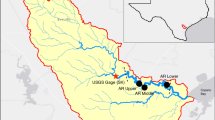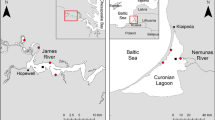Abstract
The particulate organic matter (POM) in hydrodynamically variable habitats such as the lower reaches of estuaries can change in its content and quality on very short time scales (example, hourly), and these changes can potentially influence higher-level consumers in river-estuary-marine systems. Estuarine water samples were collected hourly for 12 h downstream in a small river to evaluate the fatty acid composition of POM over a tidal cycle. Fatty acid constituents of POM collected during the flood tide were dominated by the saturated, higher plant and bacterial fatty acids, whereas unsaturated, polyunsaturated, essential, and diatom-associated fatty acids dominated the POM collected during the ebb tide. Elevated algal biomass (as indicated by high chlorophyll a concentrations), diatom, and freshness indices in the POM indicated enhanced fresh autochthonous-origin materials that dominated the mixed organic pool during the ebb tide compared to more degraded detritus during the flood tide. Tidal retention of organic matter and algal primary production were the most influential factors that differentiated the fatty acid composition of estuarine POM over the short time scale. The results of this study have important implications on the quality of POM at the time of sampling, especially in estuaries where mixed organic pools have multiple inputs and are strongly influenced by tidal cycles.






Similar content being viewed by others
References
Abed R.M.M., K. Kohls, R. Schoon, A.K. Scherf, M. Schacht, K.A. Palinska, H. Al Hassani, W. Hamza, J. Rullkötter, and S. Golubic. 2008. Lipid biomarkers, pigments and cyanobacterial diversity of microbial mats across intertidal flats of the arid coast of the Arabian Gulf (Abu Dhabi, UAE). FEMS Microbial Ecology 65: 449–462.
Ackman R.G. 1999. Comparison of lipids in marine and freshwater organisms. In Lipids in freshwater ecosystems, eds. M.T. Arts, andB.C. Wainman, 263–289. New York: Springer–Verlag Inc.
Ahlgren G., T. Vrede, and W. Goedkoop. 2009. Fatty acid ratios in freshwater fish, zooplankton and zoobenthos—are there specific optima? In Lipids in aquatic ecosystems, eds. M.T. Arts, M.T. Brett, and M.J. Kainz, 147–178. London New York: Springer Science + Business Media, LLC.
Antonio E.S., A. Kasai, M. Ueno, Y. Kurikawa, K. Tsuchiya, H. Toyohara, Y. Ishihi, H. Yokoyama, and Y. Yamashita. 2010. Consumption of terrestrial organic matter by estuarine molluscs determined by analysis of their stable isotopes and cellulase activity. Estuarine Coastal and Shelf Science 86: 401–407. doi:10.1016/j.ecss.2009.05.010.
Antonio E.S., A. Kasai, M. Ueno, Y. Ishihi, H. Yokoyama, and Y. Yamashita. 2012. Spatio–temporal feeding dynamics of benthic communities in an estuary–marine gradient. Estuarine Coastal and Shelf Science 112: 86–97. doi:10.1016/j.ecss.2011.11.017.
Antonio E.S., and N.B. Richoux. 2014. Trophodynamics of three decapod crustaceans in a temperate estuary using stable isotope and fatty acid analyses. Marine Ecology Progress Series 504: 193–205. doi:10.3354/meps10761.
Belicka L.L., D. Burkholder, J.W. Fourqurean, M.R. Heithaus, S.A. Macko, and R. Jaffé. 2012. Stable isotope and fatty acid biomarkers of seagrass, epiphytic, and algal organic matter to consumers in a pristine seagrass ecosystem. Marine and Freshwater Research 63: 1085–1097.
Bergamino L., T. Dalu, and N.B. Richoux. 2014. Evidence of spatial and temporal changes in sources of organic matter in estuarine sediments: stable isotope and fatty acid analyses. Hydrobiologia 732: 135–145. doi:10.1007/s10750-014-1853-1.
Bodineau L., G. Thoumelin, V. Béghin, and M. Wartel. 1998. Tidal time-scale changes in the composition of particulate organic matter within the estuarine turbidity maximum zone in the macrotidal Seine estuary, France: the use of fatty acid and sterol biomarkers. Estuarine Coastal and Shelf Science 47: 37–49.
Bouillon S., J.J. Middelburg, F. Dehairs, A.V. Borges, G. Abril, M.R. Flindt, S. Ulomi, and E. Kristensen. 2007. Importance of intertidal sediment processes and porewater exchange on the water column biogeochemistry in a pristine mangrove creek (Ras Dege, Tanzania). Biogeosciences 4: 311–322.
Budge S.M., and C.C. Parrish. 1998. Lipid biochemistry of plankton, settling matter and sediments in Trinity Bay. Newfoundland. II. Fatty acids. Organic Geochemistry 29: 1547–1559.
Budge S.M., C.C. Parrish, and C.H. Mckenzie. 2001. Fatty acid composition of phytoplankton, settling particulate matter and sediments at a sheltered bivalve aquaculture site. Marine Chemistry 76: 285–303. doi:10.1016/S0304-4203(01)00068-8.
Canuel E.A. 2001. Relations between river flow, primary production and fatty acid composition of particulate organic matter in San Francisco and Chesapeake Bays: a multivariate approach. Organic Geochemistry 32: 563–583.
Canuel E.A., J.E. Cloern, D.B. Ringerberg, J.B. Guckert, and G.H. Rau. 1995. Molecular and isotopic tracers used to examine sources of organic matter and its incorporation into the food webs of San Francisco Bay. Limnology and Oceanography 40: 67–81.
Canuel E.A., and C.S. Martens. 1993. Seasonal variations in the sources and alteration of organic matter associated with recently-associated sediments. Organic Geochemistry 20: 563–577.
Caramujo M.J., H.T.S. Boschker, and W. Admiraal. 2008. Fatty acid profiles of algae mark the development and composition of harpacticoid copepods. Freshwater Biology 53: 77–90.
Countway R.E., E.A. Canuel, and R.M. Dickhut. 2007. Sources of particulate organic matter in surface waters of the York River, VA estuary. Organic Geochemistry 38: 365–379. doi:10.1016/j.orggeochem.2006.06.004.
Currin C.A., S.Y. Newell, and H.W. Paerl. 1995. The role of standing dead Spartina alterniflora and benthic microalgae in salt marsh food webs: considerations based on multiple stable analysis. Marine Ecology Progress Series 121: 99–116.
Fischer A.M., J.P. Ryan, C. Levesque, and N. Welschmeyer. 2014. Characterizing estuarine plume discharge into the coastal ocean using fatty acid biomarkers and pigment analysis. Marine Environmental Research 99: 106–116. doi:10.1016/j.marenveres.2014.04.006.
Geyer W.R., and D.M. Farmer. 1989. Tide-induced variation of the dynamics of a salt wedge estuary. Journal of Physical Oceanography 19: 1060–1973.
Hammer Ø., D.A.T. Harper, and P.D. Ryan. 2001. PAST: palaeontological statistics software package for education and data analysis. Palaeontologia Electronica 4: 9.
Heinecken, T.H.E., and J.R. Grindley. 1982. Estuaries of the Cape. In Synopses of available information on individual systems, Part 2, ed A.E.F. Heydorn, and J.R. Grindley, Report No. ss10 Kowie (CSE10), CSIR Report 409, Capetown, South Africa: Creda Press.
Indarti E., M.I.A. Majid, R. Hashim, and A. Chong. 2005. Direct FAME synthesis for rapid total lipid analysis from fish oil and cod liver oil. Journal of Food Composition and Analysis 18: 161–170.
Jeffé R., G.A. Wolff, A.C. Cabrera, and H.C. Chitty. 1995. The biogeochemistry of lipids in rivers of the Orinoco Basin. Geochimica et Cosmochimica Acta 59: 4507–4522.
Kaneda T. 1991. Iso-fatty and anteiso-fatty acids in bacteria—biosynthesis, function and taxonomic significance. Microbiology Review 55: 288–302.
Kawamura K.A., and I.R. Kaplan. 1983. Organic compounds in the rainwater of Los Angeles. Environmental Science and Technology 17: 497–501.
McCallister S.L., J.E. Bauer, H.W. Ducklow, and E.A. Canuel. 2006. Sources of estuarine dissolved and particulate organic matter: a multi–tracer approach. Organic Geochemistry 37: 454–468. doi:10.1016/j.orggeochem.2005.12.005.
McManus J. 2005. Salinity and suspended matter variations in the Tay estuary. Continental Shelf Research 25: 729–747. doi:10.1016/j.csr.2004.11.003.
Richoux N.B., and R.T. Ndhlovu. 2014. Temporal shifts in the fatty acid profiles of rocky intertidal invertebrates. Marine Biology 161: 2199–2211. doi:10.1007/s00227-014-2481-z.
Richoux N.B., I. Vermeulen, and P.W. Froneman. 2014. Fatty acid profiles reveal temporal and spatial differentiation in diets within and among synoptic rocky shore suspension–feeders. Marine Ecology Progress Series 495: 143–160.
Rueda J.L., and A.C. Smaal. 2002. Physiological response of Spisula subtruncata (da Costa, 1778) to different seston quantity and quality. Hydrobiologia 475(476): 505–511.
Sakdullah A., and M. Tsuchiya. 2009. The origin of particulate organic matter and the diet of tilapia from an estuarine ecosystem subjected to domestic wastewater discharge: fatty acid analysis approach. Aquatic Ecology 43: 577–589.
Thoumelin G., L. Bodineau, and M. Wartel. 1997. Origin and transport of organic matter across the Seine Estuary: fatty acid and sterol variations. Marine Chemistry 58: 59–71.
Volkman J.K., S.W. Jeffrey, P.D. Nichols, G.I. Rogers, and C.D. Garland. 1989. Fatty acid and lipid composition of 10 species of microalgae used in mariculture. Journal of Experimental Marine Biology and Ecology 128: 219–240. doi:10.1016/0022-0981(89)90029-4.
Vorwerk P.D., and P.W. Froneman. 2009. The importance of estuarine-derived carbon for the nearshore marine environment: studies on two contrasting South African estuaries. African Journal of Aquatic Science 34: 137–146.
Wakeham S.G., and E.A. Canuel. 1990. Fatty acids and sterols of particulate matter in brackish and seasonally anoxic coastal salt pond. Advances in Organic Geochemistry 16: 703–713.
Watanabe, K., A. Kasai, E.A. Antonio, K. Suzuki, M. Ueno, and Y. Yamashita. 2014. Influence of salt–wedge intrusion on ecological processes at lower trophic levels in the Yura Estuary, Japan. Estuarine Coastal and Shelf Science 139: 67–77. http://dx.doi.org/10.1016/j.ecss.2013.12.018.
Xu Y., and R. Jaffé. 2007. Lipid biomarkers in suspended particles from a subtropical estuary: assessment of seasonal changes in sources and transport of organic matter. Marine Environmental Research 64: 666–678. doi:10.1016/j.marenvres.2007.07.004.
Acknowledgments
E.S.A. and the research were funded by the South African National Research Foundation and Rhodes University. The comments and suggestions by the anonymous reviewers and the editor that greatly improved the quality of this paper are greatly appreciated. We are grateful to Mr. and Mrs. Tyson for the use of their backyard as our temporary field laboratory in Port Alfred. We thank G. Schaal and R.T. Ndhlovu for the assistance during sampling and B. Hubbart, L. Chari and S. Moyo for the technical assistance.
Author information
Authors and Affiliations
Corresponding author
Additional information
Communicated by Marianne Holmer
Electronic Supplementary Material
Supplemental Table 1
(DOCX 158 kb)
Supplemental Table 2
(DOCX 154 kb)
Rights and permissions
About this article
Cite this article
Antonio, E.S., Richoux, N.B. Tide-Induced Variations in the Fatty Acid Composition of Estuarine Particulate Organic Matter. Estuaries and Coasts 39, 1072–1083 (2016). https://doi.org/10.1007/s12237-015-0049-x
Received:
Revised:
Accepted:
Published:
Issue Date:
DOI: https://doi.org/10.1007/s12237-015-0049-x




